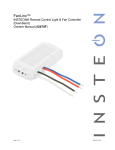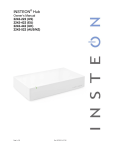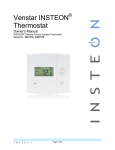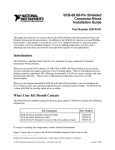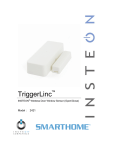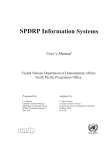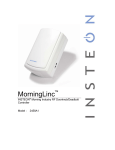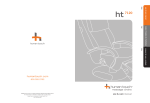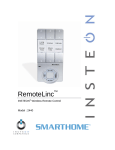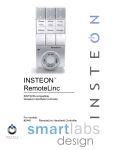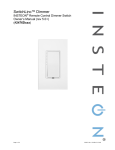Download Smarthome 2473S User's Manual
Transcript
OutletLinc ™ INSTEON® Remote Control Outlet Model : 2473S OutletLinc Owner’s Manual TABLE OF CONTENTS ABOUT OUTLETLINC.................................................................................................................................. 3 Key OutletLinc Features ............................................................................................................................ 3 What is Included with OutletLinc ............................................................................................................... 3 WHAT IS INSTEON?.................................................................................................................................... 4 INSTALLATION............................................................................................................................................ 4 Tools You Will Need .................................................................................................................................. 4 Preparing to Install OutletLinc ................................................................................................................... 5 Identifying the Electrical Wires in your Home............................................................................................ 6 Installing OutletLinc ................................................................................................................................... 6 USING OUTLETLINC ................................................................................................................................... 6 CONTROLLING OUTLETLINC FROM AN INSTEON CONTROLER ......................................................... 7 Linking an INSTEON Controller to OutletLinc ........................................................................................... 7 Unlinking OutletLinc from an INSTEON Controller ................................................................................... 7 CREATING INSTEON SCENES .................................................................................................................. 7 ADVANCED FEATURES ............................................................................................................................. 8 Enabling / Disabling Load Sensing............................................................................................................ 8 Restoring Power to OutletLinc................................................................................................................... 9 Resetting OutletLinc to its Factory Default Settings.................................................................................. 9 X10 PROGRAMMING OPTIONS ............................................................................................................... 10 Setting the X10 Primary Address ............................................................................................................ 10 Removing the X10 Primary Address ....................................................................................................... 10 About X10 Scene Address Programming................................................................................................ 11 Remotely Setting an X10 Scene Address ............................................................................................... 11 Remotely Removing an X10 Scene Address .......................................................................................... 11 ABOUT INSTEON ...................................................................................................................................... 12 Using Dual-Band INSTEON Devices to Upgrade Your Network............................................................. 12 Important Note about INSTEON Networks; Split Single-Phase vs. 3-Phase Installation ....................... 12 Further Enhancing Reliability .................................................................................................................. 12 ADDITIONAL RESOURCES ...................................................................................................................... 12 TROUBLESHOOTING................................................................................................................................ 13 SPECIFICATIONS, CERTIFICATION, AND WARRANTY ........................................................................ 14 Specifications .......................................................................................................................................... 14 Certification.............................................................................................................................................. 14 Limited Warranty ..................................................................................................................................... 14 OutletLinc Owner’s Manual ABOUT OUTLETLINC OutletLinc presents you with an elegant, stylish, and unobtrusive way to add remote control capabilities to any plug-in devices or appliances. Controlled outlet Status LED Uncontrolled outlet Set button Wallplate (sold separately) Key OutletLinc Features • Once installed, setup is easy – Links to other INSTEON devices in minutes • Controls standard incandescent lamps up to 480 Watts and inductive loads up to 15 Amps • Top outlet is INSTEON-controlled, bottom outlet is always on • Set button also doubles as an On/Off button for added convenience • Indicates INSTEON setup mode activity with a Status LED • Load Sensing easily enabled and disabled • Stores setup state in memory so settings aren’t lost during power outages • Wires into standard J-boxes (requires a NEUTRAL connection) • Two-year warranty What is Included with OutletLinc • OutletLinc – INSTEON Remote Control Outlet • Three (3) wire nuts • Quick-Start Guide Page 3 of 14 OutletLinc Owner’s Manual WHAT IS INSTEON? Since its inception in 2005, INSTEON has become a best-selling home-control networking technology, offering more reliability and flexibility than any other home management system on the market. INSTEON systems are simple, reliable, and affordable. Simple, because each device takes mere minutes to install. Reliable, because every INSTEON device works as a network repeater, ensuring your commands will not be lost. Affordable, because INSTEON can be integrated into any number of devices easily and at a very low cost. An INSTEON home grows in value with each added INSTEON device, making life more convenient, safe, and fun. How Does INSTEON Work? What makes INSTEON the most reliable home automation network is its dual-mesh network. INSTEON devices use both radio frequency (RF) signals and the home’s existing wiring to talk to each other. In an INSTEON network, every INSTEON device also acts as a repeater, receiving and sending every message to all other devices in the network. So by integrating more INSTEON devices you will strengthen the network and ensure no commands will be lost. No central controller or networking setup is required with an INSTEON network. Simply install your devices and then use a series of button presses or taps to Link your devices together. Throughout this Owner’s Manual, you may see the terms “Controller” or “Responder”. These generic INSTEON terms refer to the components of an INSTEON scene, and are used on a scene-by-scene basis. • Controller – sends INSTEON commands to other devices • Responder – reacts to commands sent out by another INSTEON device An INSTEON device may act as a Controller, Responder, or sometimes both. INSTEON networks are also extremely secure. Each INSTEON device is assigned a unique INSTEON ID, so unless neighbors or would-be hackers have access to your particular device’s INSTEON ID, they won’t be able to control your home, even if they are using similar products. INSTALLATION Tools You Will Need • Screwdrivers (both Flathead and Phillips) • Voltage tester • Wire cutter / stripper Page 4 of 14 OutletLinc Owner’s Manual Preparing to Install OutletLinc CAUTION Read and understand these instructions before installing and retain them for future reference. OutletLinc is intended for installation in accordance with the National Electric Code and local regulations in the United States or the Canadian Electrical Code and local regulations in Canada. Use indoors only. OutletLinc is not designed nor approved for use on power lines other than 120V 60Hz, single phase. Attempting to use OutletLinc on non-approved power lines may have hazardous consequences. Prior to installing OutletLinc, please review the entire installation procedure and take the following precautions: • Use indoors or in a properly insulated and weatherproof electrical box only • Be sure that you have turned off the circuit breaker or removed the fuse for the circuit you are installing OutletLinc in. Installing OutletLinc with the power on will expose you to dangerous voltages. • Connect only copper or copper-clad wire to OutletLinc • OutletLinc may feel warm during operation. The amount of heat generated is within approved limits and poses no hazards. To minimize heat buildup, ensure that the area surrounding the rear of OutletLinc has adequate ventilation by clearing away excess insulation. • OutletLinc requires a small amount of power to operate, which it receives from a connection to the NEUTRAL electrical wire (usually white). If you are replacing a standard outlet with OutletLinc, the outlet you are replacing may not normally have a connection to the NEUTRAL wire. However, most junction boxes will contain a NEUTRAL wire that you can connect OutletLinc to. If the junction box does not contain a NEUTRAL wire, please contact the INSTEON Gold Support Line or consult an electrician. • Each OutletLinc is assigned a unique INSTEON ID, which is printed on the device’s label. It is recommended that you prepare a list of all the devices you are installing, including their INSTEON ID and their location (e.g., 01.F7.G5, Mike’s bedroom light). It is only necessary to know the INSTEON IDs if you will be using optional automation software (such as Smarthome’s HouseLinc) to program and control your devices. However, it will be helpful to have a list of your devices, should you choose to use automation software later. Creating a list prior to installation will prevent you from needing to re-open all the junction boxes and fixtures to determine the INSTEON IDs. • Don’t stack INSTEON devices together by plugging them into one another. Stacked devices may overheat and stop functioning. Also avoid using the top outlet on OutletLinc for other heatgenerating power supplies. IMPORTANT! If you are not knowledgeable about and comfortable with electrical circuitry, you should have a qualified electrician install OutletLinc for you. If you have any questions, please consult an electrician or call: INSTEON Gold Support Line 800-762-7845 Page 5 of 14 OutletLinc Owner’s Manual Identifying the Electrical Wires in your Home To install OutletLinc, you will need to identify the following four wires: • LINE - usually black, may also be called HOT or LIVE, carries electricity into the switch • LOAD - usually black, red, or blue, carries electricity away from the switch and to the load • NEUTRAL - usually white, may not previously be connected to outlets • GROUND - bare copper wire You can usually identify the wires based on color. If you are unable to distinguish the wires by color alone (LINE and LOAD wires are often the same color), you will need a voltage tester to find the LINE wire: 1) Be sure no exposed wires are touching anything and then enable power to the switch from the circuit breaker or fuse panel 2) Use a voltage tester to find the wire that carries 110 – 120 Volts. This is the LINE wire. 3) Once you have identified the LINE wire, be sure to disable power at the circuit breaker before resuming installation If you are having difficulties identifying wires, consult an electrician to help you. Installing OutletLinc 1) At the circuit breaker or fuse panel, disconnect the power to the outlet 2) Remove the existing outlet and wallplate 3) Disconnect the wires from the outlet you are replacing and ensure that you have ½ inch of bare wires on the ends 4) To correctly identify the outlet’s LINE, NEUTRAL, and GROUND wires, enable power to the outlet from the circuit breaker, use a line voltage meter, and then turn the breaker off again. See Identifying the Electrical Wires in your Home. 5) Twist together the OutletLinc bare copper GROUND wire to the outlet’s GROUND wire with an included wire nut 6) Twist together the OutletLinc white wire to the outlet’s NEUTRAL wire (usually white) with an included wire nut 7) Twist together the OutletLinc black wire to the outlet’s LINE wire with an included wire nut 8) Ensure that all wire connectors are firmly attached and that there is no exposed copper except for the GROUND wire 9) Carefully install OutletLinc into the electrical box and replace the wallplate 10) Enable power to the fixture from the circuit breaker or fuse panel 11) Plug the lamp or appliance you wish to control into the top outlet on OutletLinc 12) Test that OutletLinc is working properly by tapping the Set button a few times The load will toggle on and off USING OUTLETLINC • Plug the device you wish to control (the load) into the top outlet on OutletLinc o Tap the Set button on OutletLinc to turn the load on and off The load will toggle on and off • Use the bottom outlet as you would a normal outlet (not INSTEON-controlled) Page 6 of 14 OutletLinc Owner’s Manual CONTROLLING OUTLETLINC FROM AN INSTEON CONTROLLER Linking an INSTEON Controller to OutletLinc To use OutletLinc as an INSTEON Responder, follow these steps to Link OutletLinc and a Controller together. Refer to the Controller’s Owner’s Manual for detailed instructions on how to properly install and Link it to OutletLinc. The following will work for the most common INSTEON devices: 1) Set the Controller to Linking Mode. (For most Controllers, press & hold an On or Scene button for 10 seconds or the Set button for 3 seconds.) You will have 4 minutes to complete the next step before Linking Mode automatically times out. 2) Press & hold the Set button on OutletLinc for 3 seconds The OutletLinc Status LED will flash once and then turn on solid The load will flash once 3) Confirm that Linking was successful by tapping the button you just Linked to on the Controller OutletLinc will respond appropriately Unlinking OutletLinc from an INSTEON Controller If you are going to discontinue using OutletLinc, it is very important that you Unlink it from any Linked Controllers. Otherwise, the Controllers will retry any commands repetitively, thus slowing down the system. The following will work for the most common INSTEON devices: 1) Set the Controller to Unlinking Mode. (For most Controllers, press & hold an On or Scene button for 10 seconds twice or the Set button for 3 seconds twice.) You will have 4 minutes to complete the next step before Unlinking Mode automatically times out. 2) Press & hold the Set button on OutletLinc for 3 seconds The OutletLinc Status LED will flash once and then turn on solid The load will turn on 3) Confirm that Unlinking was successful by tapping the button you just Unlinked from on the Controller OutletLinc will no longer respond CREATING INSTEON SCENES INSTEON scenes let you activate dramatic lighting moods with the tap of just one button. For example, you can set all the lights in a scene to dim to 50% or turn certain lights on while turning others off, all with the tap of a button on a Controller. INSTEON scenes are very easy to set up – just Link more than one Responder to the same On/Off or Scene button on a Controller. Then, when you tap any of the Linked buttons on the Controller, all of the INSTEON devices Linked in the scene will respond as a group. Page 7 of 14 OutletLinc Owner’s Manual ADVANCED FEATURES Enabling / Disabling Load Sensing Load Sensing allows you to manually turn on the load plugged into OutletLinc by using the switch on the load itself, without sending a command from an INSTEON or X10 controller. When the load is in the off state (with Load Sensing enabled), OutletLinc will “sense” that you are trying to turn it on with its built-in switch. When OutletLinc senses this, it will turn on the load automatically. NOTE: With Load Sensing enabled, some devices have been known to turn on OutletLinc after you have turned it off. Please use this feature with caution. By default, Load Sensing is disabled on OutletLinc. Enable Load Sensing 1) Press & hold the Set button on OutletLinc for 3 seconds The OutletLinc Status LED will begin blinking 2) Triple-tap the Set button on OutletLinc The OutletLinc Status LED will stop blinking and turn on solid 3) Test that Load Sensing has been enabled by turning the load on and off from its built-in switch The load will turn on and off Disable Load Sensing 1) Press & hold the Set button on OutletLinc for 3 seconds The OutletLinc Status LED will begin blinking 2) Double-tap the Set button on OutletLinc The OutletLinc Status LED will stop blinking and turn on solid 3) Test that Load Sensing has been disabled by turning the load on and off from its manual switch The load will not respond Page 8 of 14 OutletLinc Owner’s Manual Restoring Power to OutletLinc OutletLinc stores all of its settings, such as Links to other INSTEON devices, On-Levels/Ramp Rates, etc., with non-volatile memory. Because settings are saved in this non-volatile memory, they will not be lost in the event of a power failure. In the event of a power loss OutletLinc will automatically return the load to the brightness level it had before power was interrupted. Resetting OutletLinc to its Factory Default Settings The factory reset procedure can be used to clear the OutletLinc memory of all INSTEON Links and any programmed X10 addresses. Depending on where OutletLinc is located, you can use one of two reset methods. The easiest way to reset OutletLinc involves removing power via the circuit breaker. You may need to ask someone to help you complete the following instructions: 1) If you are using a Controller to control OutletLinc, be sure to Unlink it from the Controller. See Unlinking OutletLinc from an INSTEON Controller. 2) As you remove power at the circuit breaker, press & hold the Set button on OutletLinc 3) Wait 10 seconds 4) Press & hold the Set button on OutletLinc while you restore power at the circuit breaker 5) Continue to hold down the Set button for 3 seconds and then release The OutletLinc Status LED will turn on bright and solid and then turn off After a few seconds, the Status LED will turn on solid If the placement of OutletLinc makes the first method too difficult, try manually resetting the unit with the following instructions: 1) If you are using a Controller to control OutletLinc, be sure to Unlink it from the Controller. See Unlinking OutletLinc from an INSTEON Controller. 2) Tap the Set button on OutletLinc until the load is on 3) Press & hold the Set button on OutletLinc for 3 seconds The OutletLinc Status LED will begin blinking 4) Wait 3 seconds and then tap the Set button on OutletLinc five times quickly The OutletLinc Status LED and the load will turn off 5) Immediately after the LED turns off, press & hold the button for 3 seconds and then release The OutletLinc Status LED will flash once and then turn off A few seconds later, the Status LED will turn on solid Page 9 of 14 OutletLinc Owner’s Manual X10 PROGRAMMING OPTIONS OutletLinc is X10 ready, meaning that it can respond to X10 commands from X10 controllers. However, to operate OutletLinc in X10 mode, you must first set up an X10 address. As it ships from the factory or after a factory reset procedure, OutletLinc will have not have an X10 address set up. Setting the X10 Primary Address 1) Set OutletLinc to Linking Mode by pressing & holding the Set button for 3 seconds The OutletLinc Status LED will begin blinking You will have 4 minutes to complete the next step before Linking Mode automatically times out. 2) Using an X10 controller, send the X10 address you want to assign and the ON command three times For example, to assign the address A1, you would send “A1 ON A1 ON A1 ON.” 3) Once OutletLinc has received the sequence, it will exit Linking Mode The OutletLinc Status LED will stop blinking and turn on solid Removing the X10 Primary Address If you are no longer going to control OutletLinc with an X10 address, it is very important that you Unlink it. Otherwise, OutletLinc will still respond to X10 commands and may cause OutletLinc to turn on by itself. 1) Set OutletLinc to Linking Mode by pressing & holding the Set button for 3 seconds The OutletLinc Status LED will begin blinking 2) Set OutletLinc to Unlinking Mode by pressing & holding the Set button for 3 seconds again The OutletLinc Status LED will continue blinking You will have 4 minutes to complete the next step before Unlinking Mode automatically times out. 3) Using an X10 controller, send the X10 address you wish to remove and the ON command three times For example, to remove the address A1, you would send “A1 ON A1 ON A1 ON”. 4) Once OutletLinc has received the sequence, it will exit Unlinking Mode The OutletLinc Status LED will stop blinking and turn on solid Page 10 of 14 OutletLinc Owner’s Manual About X10 Scene Address Programming OutletLinc can be a member of up to 255 X10 scenes. An X10 scene address is just another X10 address like the X10 Primary Address. When an X10 command is sent to an X10 scene address, every X10 device with that address will turn on to its independent On-Level at its independent Ramp Rate (if a dimmable device). Sending an X10 OFF command to an X10 scene address will turn off all devices that are members of that X10 scene, each at its independent Ramp Rate. X10 devices will react to DIM and BRIGHT commands after the X10 scene address is sent (if the device is a dimmer). However, they will ignore ALL ON and ALL OFF commands for the X10 scene address. Remotely Setting an X10 Scene Address 1) Using an X10 controller, send the CLEAR sequence: O16 N16 M16 P16 M16 2) Set the X10 scene address state by turning OutletLinc on or off. If you skip this step, the current state will be used. 3) Send the following X10 address sequence: M16 N16 O16 P16 4) Send the desired X10 scene address (house code and unit code) to lock in the new On-Level and X10 scene address Remotely Removing an X10 Scene Address 1) Using an X10 controller, send the CLEAR sequence: O16 N16 M16 P16 M16 2) Send the OutletLinc’s X10 Primary Address 3) Send an X10 ON or OFF command 4) Send the following X10 address sequence: O16 P16 M16 N16 5) Send the X10 scene address (house code and unit code) that you wish to remove Page 11 of 14 OutletLinc Owner’s Manual ABOUT INSTEON Using Dual-Band INSTEON Devices to Upgrade Your Network What are phases? The majority of single-family homes in North America have two phases (or “legs”) of 110 Volts coming into their electricity panels. From the panel, they are distributed throughout the home, providing power to outlets and wall switches. These phases come together in some parts of the home to provide 220 Volts of power to large appliances, such as an electric oven or pool pump. Why do I need to bridge these phases? Single-band power line devices send commands via the home’s electricity, but only on a single phase. If the command is intended for a device on the opposite phase, there is a good chance the command will go unnoticed. Installing dual-band INSTEON devices, such as Access Points (#2443), on each phase will allow for devices to communicate between the two phases via RF. Dual-band INSTEON devices embody the full potential of a true INSTEON mesh network. Taking the power line band signal and working in conjunction with the RF band signal, its dual-band function plays out in two ways: • Phase bridger – a receiver of commands, reacting to and translating signals sent from one power phase to the opposite via RF • Signal repeater – a participant in an INSTEON network, repeating commands intended for other devices whether those commands are generated from RF or power line-only devices. To ensure reliability, every INSTEON device confirms that it has received a command. If a Controller does not receive this confirmation, it will automatically retransmit the command up to five times. While using at least one dual-band device is required when using an RF-only device, at least two dual-band devices are recommended in any INSTEON network to ensure reliable communication across two-phase home wiring systems. For larger applications, it is recommended to install at least one dual-band device for every 750 – 1,000 square feet. Search for dual-band INSTEON devices at: www.smarthome.com/dualband Important Note about INSTEON Networks; Split Single-Phase vs. 3-Phase Installation For the best INSTEON network performance, be sure you have properly installed at least two dual-band INSTEON devices. INSTEON has only been officially tested in a split single-phase residential environment but has been known to work in many 3-phase systems, where three dual-band devices are used (one on each phase). However, due to the potential complexity of its troubleshooting, the INSTEON Gold Support Line is unable to support INSTEON in 3-phase environments. Further Enhancing Reliability As signals travel via the power line or RF throughout the home, they naturally become weaker the farther they travel. The best way to overcome weakened signals is to increase the coverage of the mesh network by introducing more INSTEON devices. It is possible that some audio-video devices, computers, power strips, or other electrical equipment may attenuate INSTEON signals on the power line. You can temporarily unplug suspected devices to test whether the INSTEON signal improves. If it does, then you can plug in filters that will permanently fix the problem. ADDITIONAL RESOURCES Find home automation solutions, helpful tips, interactive demos, videos, user forums, and more at the Smarthome Learning Center: www.smarthome.com/learningcenter.html Page 12 of 14 OutletLinc Owner’s Manual TROUBLESHOOTING Problem Possible Cause The Status LED on OutletLinc may not be getting OutletLinc is not turning on power. and won’t control the load. OutletLinc won’t Link or work with a Controller. OutletLinc is taking a long time to respond to a Controller. Solution Make sure the circuit breaker is turned on. Check the junction box wires to ensure all connections are tight and no bare wires are exposed. The Controller might have been reset without OutletLinc from it. Re-Link OutletLinc to the Controller. The Controller and OutletLinc may be on opposite power line phases. Make sure two dual-band INSTEON devices are properly installed to bridge the two power line phases. The INSTEON signal may be too weak. Add additional INSTEON devices or move around existing INSTEON devices. All INSTEON devices act as INSTEON network repeaters. Large appliances, such as refrigerators or air conditioners, may be producing electrical noise on the power line. Install a power line noise filter (#1626-10) to filter electrical noise and minimize signal attenuation. Other electrical devices, such as computers, televisions, or power strips, may be absorbing the INSTEON signal. The Controller may be sending commands to a Responder that is no longer in use. Commands for the unused Responder are being resent and loading down the signal. Unlink any unused Responders from the Controller. HINT: If you are using home automation software, you can easily check scene membership and eliminate unnecessary Links. If the above doesn’t work, perform a factory reset on the Controller. Load Sensing may have been triggered. Disable Load Sensing. See Enabling / Disabling Load Sensing. Another Controller, a timer, or stray X10 signals could have triggered OutletLinc. Perform a factory reset. See Resetting OutletLinc to its Factory Default Settings. The Controller can turn off OutletLinc, but OutletLinc does not turn on when I send an ON command from the Controller. OutletLinc may be Linked at its off state. Re-Link OutletLinc to the Controller, while the load is on. See Linking an INSTEON Controller to OutletLinc. OutletLinc is locked up. A surge or excessive noise on the power line may have glitched it. Perform a factory reset. See Resetting OutletLinc to its Factory Default Settings. The LEDS controlled by OutletLinc do not turn off completely when I send an OFF command. You may be using a lowwattage LED. Since LEDs don’t take a lot of power, the trickle- Add to the load with more LEDs or higher wattage bulbs – generally higher than a 5 Watt load. charge that runs through OutletLinc may be enough to power the bulb. The load turned on by itself. If you have tried these solutions, reviewed this Owner’s Manual, and still cannot resolve an issue you are having with OutletLinc, please call: INSTEON Gold Support Line 800-762-7845 Page 13 of 14 OutletLinc Owner’s Manual SPECIFICATIONS, CERTIFICATION, AND WARRANTY Specifications View specifications for OutletLinc at: www.smarthome.com/2473SWH.html Certification This product has been thoroughly tested by ITS ETL SEMKO, a nationally recognized independent third-party testing laboratory. The North American ETL Listed mark signifies that the device has been tested to and has met the requirements of a widely recognized consensus of U.S. and Canadian device safety standards, that the manufacturing site has been audited, and that the manufacturer has agreed to a program of quarterly factory followup inspections to verify continued conformance. Limited Warranty Seller warrants to the original consumer purchaser of this product that, for a period of two years from the date of purchase, this product will be free from defects in material and workmanship and will perform in substantial conformity to the description of the product in this Owner’s Manual. This warranty shall not apply to defects or errors caused by misuse or neglect. If the product is found to be defective in material or workmanship, or if the product does not perform as warranted above during the warranty period, Seller will either repair it, replace it, or refund the purchase price, at its option, upon receipt of the product at the address below, postage prepaid, with proof of the date of purchase and an explanation of the defect or error. The repair, replacement, or refund that is provided for above shall be the full extent of Seller’s liability with respect to this product. For repair or replacement during the warranty period, call the INSTEON Gold Support Line at 800-762-7845 with the Model # and Revision # of the device to receive an RMA# and send the product, along with all other required materials to: Smarthome, Inc. ATTN: Receiving Dept. 16542 Millikan Ave. Irvine, CA 92606-5027 Limitations The above warranty is in lieu of and Seller disclaims all other warranties, whether oral or written, express or implied, including any warranty or merchantability or fitness for a particular purpose. Any implied warranty, including any warranty of merchantability or fitness for a particular purpose, which may not be disclaimed or supplanted as provided above shall be limited to the two-year of the express warranty above. No other representation or claim of any nature by any person shall be binding upon Seller or modify the terms of the above warranty and disclaimer. Home automation devices have the risk of failure to operate, incorrect operation, or electrical or mechanical tampering. For optimal use, manually verify the device state. Any home automation device should be viewed as a convenience, but not as a sole method for controlling your home. In no event shall Seller be liable for special, incidental, consequential, or other damages resulting from possession or use of this device, including without limitation damage to property and, to the extent permitted by law, personal injury, even if Seller knew or should have known of the possibility of such damages. Some states do not allow limitations on how long an implied warranty lasts and/or the exclusion or limitation of damages, in which case the above limitations and/or exclusions may not apply to you. You may also have other legal rights that may vary from state to state. INSTEON Technology Patent U.S Patent No. 7,345,998, International patents pending © Copyright 2011 Smarthome, 16542 Millikan Ave., Irvine, CA 92606, 800-762-7845, www.smarthome.com Rev 04-28-2011 Page 14 of 14
















